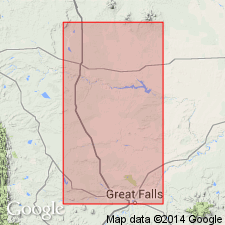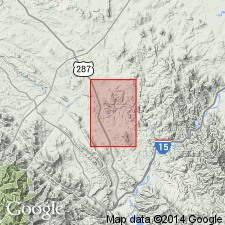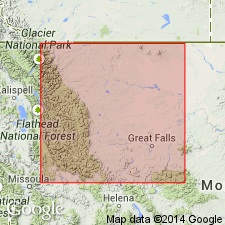
- Usage in publication:
-
- Floweree member*
- Modifications:
-
- Named
- Dominant lithology:
-
- Shale
- Siltstone
- AAPG geologic province:
-
- Sweetgrass arch
Summary:
Named as basal member of Marias River shale (new) of Colorado group (rank raised) for station of Floweree, Great Northern Railway E1/2 SE1/4 sec 24, T23N, R5E and contiguous part of sec 19, T23N, R6E, Chouteau Co, MT on the Sweetgrass arch. Type section is 2 mi northeast of Floweree on north side of Black Coulee in S1/2 NE1/4 sec 17 and SW1/4 NW1/4 sec 16, T23N, R6E. Is 63 ft thick at type. Consists chiefly of non-calcareous dark gray shale, medium gray siltstone containing small limestone concretions and lentils of sandy siltstone, and fine-grained sandstone that may contain scattered granules of dark gray chert. Rests with obscure disconformity on Bootlegger member (new) of Blackleaf formation. Underlies Cone calcareous member (new) of Marias River unconformably. Correlates with lower part of Greenhorn formation or limestone. Of Cenomanian, Late Cretaceous age. Correlation chart.
Source: GNU records (USGS DDS-6; Denver GNULEX).

- Usage in publication:
-
- Floweree Shale Member*
- Modifications:
-
- Overview
- AAPG geologic province:
-
- Montana folded belt
Summary:
Is mapped as basal member of Marias River Shale in eastern Lewis and Clark Co, MT in Montana folded belt province. Is mapped with Cone Calcareous Member of Marias River. Unconformably overlies Blackleaf Formation (not exposed); underlies Cone Member. Is dark-gray to olive-gray, poorly to moderately fissile, noncalcareous shale and one or more thin beds of yellowish-gray and yellowish-orange bentonite; invertebrate fossils scarce; base not exposed; maximum exposed thickness about 30 ft. Age is Late Cretaceous.
Source: GNU records (USGS DDS-6; Denver GNULEX).

- Usage in publication:
-
- Floweree Member*
- Modifications:
-
- Overview
- AAPG geologic province:
-
- Sweetgrass arch
Summary:
Is the basal member of Marias River Shale of Colorado Group on the Sweetgrass arch. Exposed along south part of South arch, crest of Kevin-Sunburst dome, Sweetgrass Hills, and Rocky Mountain front. Varies from 3 m to 45.7 m thick. Detailed description of type measured section. Contains worm burrows or casts, and ammonite fossils. Of Late Cretaceous, Cenomanian age. [A late Cenomanian age assigned to Floweree (oral communication, W. A. Cobban to C. A. Wallace, 1-10-89). Age based on ammonite CALYCOCERAS? CANITAURINUM found 25 ft below top of member at its type; this is lowest occurring fossil in member at its type (twj 1-10-89).]
Source: GNU records (USGS DDS-6; Denver GNULEX).
For more information, please contact Nancy Stamm, Geologic Names Committee Secretary.
Asterisk (*) indicates published by U.S. Geological Survey authors.
"No current usage" (†) implies that a name has been abandoned or has fallen into disuse. Former usage and, if known, replacement name given in parentheses ( ).
Slash (/) indicates name conflicts with nomenclatural guidelines (CSN, 1933; ACSN, 1961, 1970; NACSN, 1983, 2005, 2021). May be explained within brackets ([ ]).

